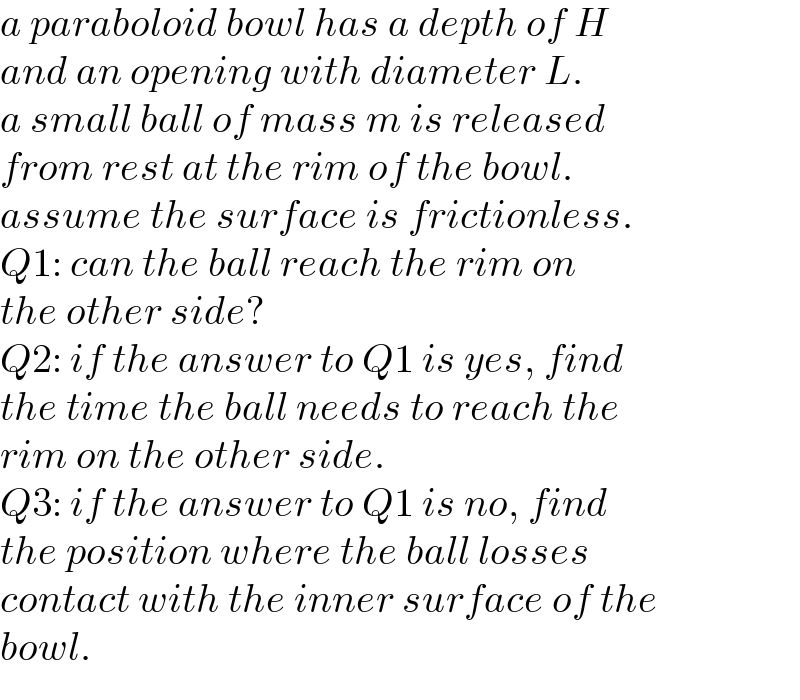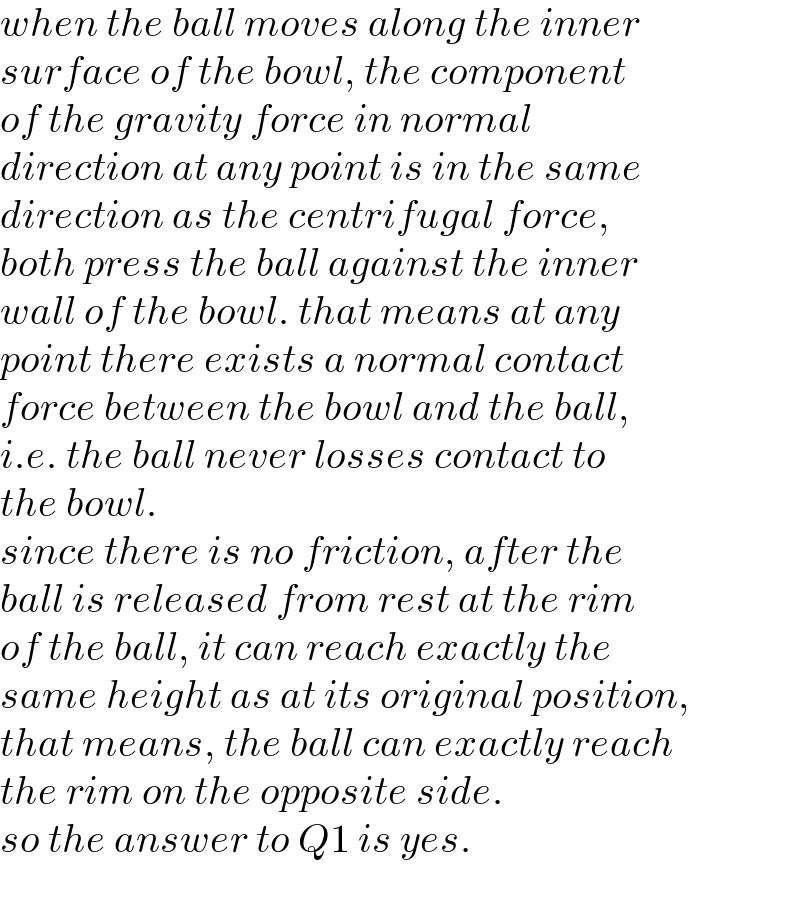Question Number 127811 by mr W last updated on 02/Jan/21

Commented by mr W last updated on 02/Jan/21

$${a}\:{paraboloid}\:{bowl}\:{has}\:{a}\:{depth}\:{of}\:{H} \\ $$$${and}\:{an}\:{opening}\:{with}\:{diameter}\:{L}. \\ $$$${a}\:{small}\:{ball}\:{of}\:{mass}\:{m}\:{is}\:{released} \\ $$$${from}\:{rest}\:{at}\:{the}\:{rim}\:{of}\:{the}\:{bowl}. \\ $$$${assume}\:{the}\:{surface}\:{is}\:{frictionless}. \\ $$$${Q}\mathrm{1}:\:{can}\:{the}\:{ball}\:{reach}\:{the}\:{rim}\:{on} \\ $$$${the}\:{other}\:{side}? \\ $$$${Q}\mathrm{2}:\:{if}\:{the}\:{answer}\:{to}\:{Q}\mathrm{1}\:{is}\:{yes},\:{find} \\ $$$${the}\:{time}\:{the}\:{ball}\:{needs}\:{to}\:{reach}\:{the} \\ $$$${rim}\:{on}\:{the}\:{other}\:{side}. \\ $$$${Q}\mathrm{3}:\:{if}\:{the}\:{answer}\:{to}\:{Q}\mathrm{1}\:{is}\:{no},\:{find} \\ $$$${the}\:{position}\:{where}\:{the}\:{ball}\:{losses} \\ $$$${contact}\:{with}\:{the}\:{inner}\:{surface}\:{of}\:{the} \\ $$$${bowl}. \\ $$
Answered by mr W last updated on 03/Jan/21

$${when}\:{the}\:{ball}\:{moves}\:{along}\:{the}\:{inner} \\ $$$${surface}\:{of}\:{the}\:{bowl},\:{the}\:{component} \\ $$$${of}\:{the}\:{gravity}\:{force}\:{in}\:{normal}\: \\ $$$${direction}\:{at}\:{any}\:{point}\:{is}\:{in}\:{the}\:{same} \\ $$$${direction}\:{as}\:{the}\:{centrifugal}\:{force}, \\ $$$${both}\:{press}\:{the}\:{ball}\:{against}\:{the}\:{inner} \\ $$$${wall}\:{of}\:{the}\:{bowl}.\:{that}\:{means}\:{at}\:{any} \\ $$$${point}\:{there}\:{exists}\:{a}\:{normal}\:{contact} \\ $$$${force}\:{between}\:{the}\:{bowl}\:{and}\:{the}\:{ball}, \\ $$$${i}.{e}.\:{the}\:{ball}\:{never}\:{losses}\:{contact}\:{to} \\ $$$${the}\:{bowl}. \\ $$$${since}\:{there}\:{is}\:{no}\:{friction},\:{after}\:{the} \\ $$$${ball}\:{is}\:{released}\:{from}\:{rest}\:{at}\:{the}\:{rim} \\ $$$${of}\:{the}\:{ball},\:{it}\:{can}\:{reach}\:{exactly}\:{the} \\ $$$${same}\:{height}\:{as}\:{at}\:{its}\:{original}\:{position}, \\ $$$${that}\:{means},\:{the}\:{ball}\:{can}\:{exactly}\:{reach} \\ $$$${the}\:{rim}\:{on}\:{the}\:{opposite}\:{side}. \\ $$$${so}\:{the}\:{answer}\:{to}\:{Q}\mathrm{1}\:{is}\:{yes}. \\ $$
Commented by mr W last updated on 03/Jan/21

Commented by mr W last updated on 03/Jan/21
![let R=(L/2)=radius of opening y=H((x/R))^2 let η=(H/R), ξ=(x/R)∈[−1,1] y′=2H(x/R^2 )=2ηξ y′′=2(H/R^2 )=((2η)/R) radius of curvature r=(([1+(y′)^2 ]^(3/2) )/(∣y′′∣)) ⇒r=(((1+4η^2 ξ)^(3/2) R)/(2η)) (1/2)mv^2 =mg(H−y)=mg(H−Hξ^2 ) ⇒v^2 =2gH(1−ξ^2 ) ⇒v=(√(2gH(1−ξ^2 ))) ds=(√(1+(y′)^2 ))dx=R(√(1+4η^2 ξ^2 ))dξ dt=(ds/v)=(R/( (√(2gH))))(√((1+4η^2 ξ^2 )/(1−ξ^2 )))dξ the time the ball needs to move from rim to rim is T. T=(R/( (√(2gH))))∫_(−1) ^1 (√((1+4η^2 ξ^2 )/(1−ξ^2 )))dξ =((2R)/( (√(2gH))))∫_0 ^1 (√((1+4η^2 ξ^2 )/(1−ξ^2 )))dξ ⇒T=(√((2H)/g))×(1/η)∫_0 ^1 (√((1+4η^2 ξ^2 )/(1−ξ^2 )))dξ=k(√((2H)/g)) with k=(1/η)∫_0 ^1 (√((1+4η^2 ξ^2 )/(1−ξ^2 )))dξ note: (√((2H)/g)) is the time for free fall of the ball from height H. it′s obvious that k>2. an exact formula for k is not possible. examples: η=(H/R)=1 ⇒k≈2.635184 η=(H/R)=2 ⇒k≈2.203569 η=(H/R)=4 ⇒k≈2.061882 η=(H/R)=10 ⇒k≈2.012202 tan θ=(dy/dx)=2ηξ N=mg cos θ+m(v^2 /r) (N/(mg))=(1/( (√(1+4η^2 ξ^2 ))))+((4η^2 (1−ξ^2 ))/((1+4η^2 ξ^2 )^(3/2) )) =(1/( (√(1+4η^2 ξ^2 ))))+((4η^2 +1−(1+4η^2 ξ^2 ))/((1+4η^2 ξ^2 )^(3/2) )) ⇒(N/(mg))=((1+4η^2 )/((1+4η^2 ξ^2 )^(3/2) )) >0 at ξ=±1: N_(min) =((mg)/( (√(1+4η^2 )))) at ξ=0: N_(max) =(1+4η^2 )mg](https://www.tinkutara.com/question/Q127923.png)
$${let}\:{R}=\frac{{L}}{\mathrm{2}}={radius}\:{of}\:{opening} \\ $$$${y}={H}\left(\frac{{x}}{{R}}\right)^{\mathrm{2}} \\ $$$${let}\:\eta=\frac{{H}}{{R}},\:\xi=\frac{{x}}{{R}}\in\left[−\mathrm{1},\mathrm{1}\right] \\ $$$${y}'=\mathrm{2}{H}\frac{{x}}{{R}^{\mathrm{2}} }=\mathrm{2}\eta\xi \\ $$$${y}''=\mathrm{2}\frac{{H}}{{R}^{\mathrm{2}} }=\frac{\mathrm{2}\eta}{{R}} \\ $$$${radius}\:{of}\:{curvature}\:{r}=\frac{\left[\mathrm{1}+\left({y}'\right)^{\mathrm{2}} \right]^{\frac{\mathrm{3}}{\mathrm{2}}} }{\mid{y}''\mid} \\ $$$$\Rightarrow{r}=\frac{\left(\mathrm{1}+\mathrm{4}\eta^{\mathrm{2}} \xi\right)^{\frac{\mathrm{3}}{\mathrm{2}}} {R}}{\mathrm{2}\eta} \\ $$$$\frac{\mathrm{1}}{\mathrm{2}}{mv}^{\mathrm{2}} ={mg}\left({H}−{y}\right)={mg}\left({H}−{H}\xi^{\mathrm{2}} \right) \\ $$$$\Rightarrow{v}^{\mathrm{2}} =\mathrm{2}{gH}\left(\mathrm{1}−\xi^{\mathrm{2}} \right) \\ $$$$\Rightarrow{v}=\sqrt{\mathrm{2}{gH}\left(\mathrm{1}−\xi^{\mathrm{2}} \right)} \\ $$$$ \\ $$$${ds}=\sqrt{\mathrm{1}+\left({y}'\right)^{\mathrm{2}} }{dx}={R}\sqrt{\mathrm{1}+\mathrm{4}\eta^{\mathrm{2}} \xi^{\mathrm{2}} }{d}\xi \\ $$$${dt}=\frac{{ds}}{{v}}=\frac{{R}}{\:\sqrt{\mathrm{2}{gH}}}\sqrt{\frac{\mathrm{1}+\mathrm{4}\eta^{\mathrm{2}} \xi^{\mathrm{2}} }{\mathrm{1}−\xi^{\mathrm{2}} }}{d}\xi \\ $$$${the}\:{time}\:{the}\:{ball}\:{needs}\:{to}\:{move}\:{from} \\ $$$${rim}\:{to}\:{rim}\:{is}\:{T}. \\ $$$${T}=\frac{{R}}{\:\sqrt{\mathrm{2}{gH}}}\int_{−\mathrm{1}} ^{\mathrm{1}} \sqrt{\frac{\mathrm{1}+\mathrm{4}\eta^{\mathrm{2}} \xi^{\mathrm{2}} }{\mathrm{1}−\xi^{\mathrm{2}} }}{d}\xi \\ $$$$=\frac{\mathrm{2}{R}}{\:\sqrt{\mathrm{2}{gH}}}\int_{\mathrm{0}} ^{\mathrm{1}} \sqrt{\frac{\mathrm{1}+\mathrm{4}\eta^{\mathrm{2}} \xi^{\mathrm{2}} }{\mathrm{1}−\xi^{\mathrm{2}} }}{d}\xi \\ $$$$\Rightarrow{T}=\sqrt{\frac{\mathrm{2}{H}}{{g}}}×\frac{\mathrm{1}}{\eta}\int_{\mathrm{0}} ^{\mathrm{1}} \sqrt{\frac{\mathrm{1}+\mathrm{4}\eta^{\mathrm{2}} \xi^{\mathrm{2}} }{\mathrm{1}−\xi^{\mathrm{2}} }}{d}\xi={k}\sqrt{\frac{\mathrm{2}{H}}{{g}}} \\ $$$${with}\:{k}=\frac{\mathrm{1}}{\eta}\int_{\mathrm{0}} ^{\mathrm{1}} \sqrt{\frac{\mathrm{1}+\mathrm{4}\eta^{\mathrm{2}} \xi^{\mathrm{2}} }{\mathrm{1}−\xi^{\mathrm{2}} }}{d}\xi \\ $$$${note}:\:\sqrt{\frac{\mathrm{2}{H}}{{g}}}\:{is}\:{the}\:{time}\:{for}\:{free}\:{fall} \\ $$$${of}\:{the}\:{ball}\:{from}\:{height}\:{H}.\:{it}'{s}\:{obvious} \\ $$$${that}\:{k}>\mathrm{2}. \\ $$$$ \\ $$$${an}\:{exact}\:{formula}\:{for}\:{k}\:{is}\:{not}\:{possible}. \\ $$$${examples}: \\ $$$$\eta=\frac{{H}}{{R}}=\mathrm{1}\:\Rightarrow{k}\approx\mathrm{2}.\mathrm{635184} \\ $$$$\eta=\frac{{H}}{{R}}=\mathrm{2}\:\Rightarrow{k}\approx\mathrm{2}.\mathrm{203569} \\ $$$$\eta=\frac{{H}}{{R}}=\mathrm{4}\:\Rightarrow{k}\approx\mathrm{2}.\mathrm{061882} \\ $$$$\eta=\frac{{H}}{{R}}=\mathrm{10}\:\Rightarrow{k}\approx\mathrm{2}.\mathrm{012202} \\ $$$$ \\ $$$$\mathrm{tan}\:\theta=\frac{{dy}}{{dx}}=\mathrm{2}\eta\xi \\ $$$${N}={mg}\:\mathrm{cos}\:\theta+{m}\frac{{v}^{\mathrm{2}} }{{r}} \\ $$$$\frac{{N}}{{mg}}=\frac{\mathrm{1}}{\:\sqrt{\mathrm{1}+\mathrm{4}\eta^{\mathrm{2}} \xi^{\mathrm{2}} }}+\frac{\mathrm{4}\eta^{\mathrm{2}} \left(\mathrm{1}−\xi^{\mathrm{2}} \right)}{\left(\mathrm{1}+\mathrm{4}\eta^{\mathrm{2}} \xi^{\mathrm{2}} \right)^{\frac{\mathrm{3}}{\mathrm{2}}} } \\ $$$$=\frac{\mathrm{1}}{\:\sqrt{\mathrm{1}+\mathrm{4}\eta^{\mathrm{2}} \xi^{\mathrm{2}} }}+\frac{\mathrm{4}\eta^{\mathrm{2}} +\mathrm{1}−\left(\mathrm{1}+\mathrm{4}\eta^{\mathrm{2}} \xi^{\mathrm{2}} \right)}{\left(\mathrm{1}+\mathrm{4}\eta^{\mathrm{2}} \xi^{\mathrm{2}} \right)^{\frac{\mathrm{3}}{\mathrm{2}}} } \\ $$$$\Rightarrow\frac{{N}}{{mg}}=\frac{\mathrm{1}+\mathrm{4}\eta^{\mathrm{2}} }{\left(\mathrm{1}+\mathrm{4}\eta^{\mathrm{2}} \xi^{\mathrm{2}} \right)^{\frac{\mathrm{3}}{\mathrm{2}}} }\:>\mathrm{0} \\ $$$${at}\:\xi=\pm\mathrm{1}:\:{N}_{{min}} =\frac{{mg}}{\:\sqrt{\mathrm{1}+\mathrm{4}\eta^{\mathrm{2}} }} \\ $$$${at}\:\xi=\mathrm{0}:\:{N}_{{max}} =\left(\mathrm{1}+\mathrm{4}\eta^{\mathrm{2}} \right){mg} \\ $$
